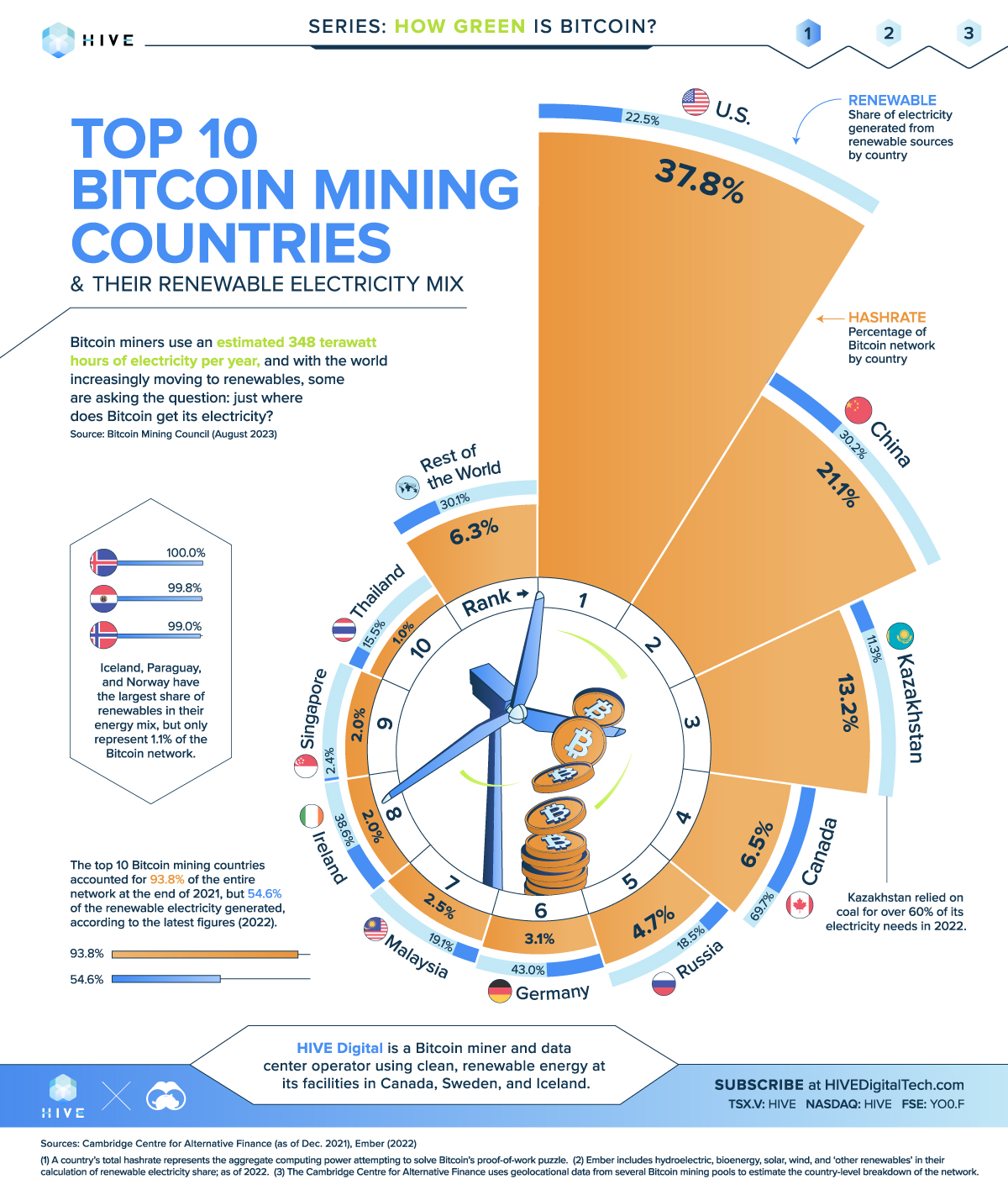Global Bitcoin Mining Landscape: A Power-Hungry Endeavor
The realm of Bitcoin mining has become a colossal consumer of electricity, devouring around 348 terawatt-hours annually. As the pivot towards renewable energy gains momentum, questions arise about the nature of the electrical sources fueling this digital mining industry. In an effort to shed light on this issue, insights from HIVE Digital, the Cambridge Centre for Alternative Finance, and Ember have been amalgamated, forming the first installment of the “How Green is Bitcoin?” series that scrutinizes the cryptocurrency’s environmental footprint.
A Deep Dive into the Top Bitcoin Mining Nations
An examination of the data unveils that ten countries significantly dominate Bitcoin’s mining activities, accounting for 93.8% of the network’s total computational prowess—referred to as hashrate—by the close of 2021. The United States leads the charge, hosting 37.8% of the global mining operations, followed by China with 21.1%, and Kazakhstan capturing 13.2%. These figures suggest that approximately three-quarters of Bitcoin mining activities were concentrated within these three nations.
A deeper look at the renewable energy usage by these countries shows varied commitments to greener solutions. While the U.S. has a renewable electricity mix of 22.5%, China’s renewable endeavors result in a higher figure of 30.2%. Kazakhstan, on the other hand, lags with only an 11.3% incorporation of renewables in their energy provision. Internationally, the renewable electricity uptake stood at 30% for the year 2022, showcasing the potential for growth in greener Bitcoin mining practices.
China, historically the behemoth in Bitcoin mining, holding up to a 75% share globally, experienced a drastic decline following rigid regulatory actions in mid-2021. The upheaval shifted the mining landscape as operations migrated to accommodating destinations like Kazakhstan—lured by affordable power and lenient governance—while others found refuge within the U.S. Despite official clampdowns, China witnessed the emergence of clandestine mining activities post-crisis.
Countries like Ireland, Singapore, and Thailand represent the lower end of the scale in terms of Bitcoin network hosting, collectively constituting 4.9%. The presented data for countries such as Germany (3.1% hashrate) and Ireland (2.0% hashrate) may be inflated as a consequence of miners concealing their actual locations.

SOURCE: visualcapitalist.com
The Influence of Climate on Mining Locations
The strategic positioning of Bitcoin mining setups is influenced by a plethora of factors, including regulatory landscapes, energy prices, and the climate. Given the propensity of mining rigs to generate excessive heat, the average ambient temperature is a consideration worth noting. The appeal of renewable energy sources is also becoming salient in miners’ decision-making processes, possibly contributing to Canada’s ascension from a minimal network presence to holding 6.5% by the end of 2021, thanks in part to its rich hydroelectric resources.
Yet, with all eyes on renewable utilization, it’s telling that countries endowed with extensive renewable capacities, such as Iceland, Paraguay, and Norway, cumulatively account for slightly over a mere one percent of the global Bitcoin mining activities, indicating ample opportunities for eco-conscious expansion within the sector.
In conclusion, as Bitcoin mining continues to intensify its energy consumption, the transition towards renewable electricity sources becomes ever more pertinent. The current geographical distribution of mining activities reveals a complex interplay between power availability, cost, regulation, and temperatures, with a budding inclination towards sustainability. We invite our readers to join the conversation and share their thoughts on the future of renewable energy in Bitcoin mining.

